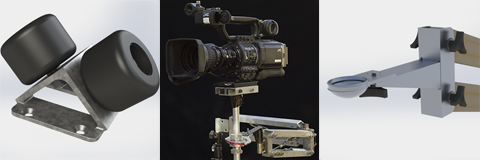
These much-used pieces of camera kit were responses to very specific problems. The jib and dolly are for ultra-low-budget international filmmaking. They're designed pack down to less than 1.5kg each, and fit in checked luggage by using locally-sourced components for their larger components. The stabiliser is a full isoelastic arm model designed for guerrilla film shoots.
International guerrilla film-making has some very specific challenges.
Directors want the flexibility of traveling with a full-scale dolly and camera jib, but oversize baggage is expensive, and often border security is wary of camera crews that look too "professional".
Each of these much-used pieces of kit is designed to pack down into a tiny package weighing less than 1.5kg, by sourcing local materials for their bulkier components. The travel packages easily fit into a checked suitcase on a commercial flight.
Directors want the flexibility of traveling with a full-scale dolly and camera jib, but oversize baggage is expensive, and often border security is wary of camera crews that look too "professional".
Each of these much-used pieces of kit is designed to pack down into a tiny package weighing less than 1.5kg, by sourcing local materials for their bulkier components. The travel packages easily fit into a checked suitcase on a commercial flight.


The jib uses two lengths of 3"x2" lumber for its arms and a bag of sand for its counterweight. The dolly wheels screw to any suitable piece of plywood, and ride on two PVC pipe "rails": all materials that are easily and cheaply sourced in the destination country. The jib can also be fitted with aluminium arms, and for in-country use it has been.
When it's time to move on, the locally sourced components can simply be removed and repurposed.
When it's time to move on, the locally sourced components can simply be removed and repurposed.
A body-mount isoelastic-arm stabiliser rig is nice to have on standby on set, or in a DOP's kit. But usually a specially trained operator is required, and they supply their own gear. It's typically too expensive to have a Steadicam operator on set 'just in case'.
This stabiliser rig was built while working on an independent feature film, so one could be on set at all times. It was made possible by the trend towards smaller, lighter HD cine cameras. It clips to the operator's torso harness, and effectively minimises unwanted camera movement through the use of a spring-and-pulley mechanism, gimbals, and counterweights. It has since been used on several short films and music videos.
This stabiliser rig was built while working on an independent feature film, so one could be on set at all times. It was made possible by the trend towards smaller, lighter HD cine cameras. It clips to the operator's torso harness, and effectively minimises unwanted camera movement through the use of a spring-and-pulley mechanism, gimbals, and counterweights. It has since been used on several short films and music videos.

The video here is just from a test shoot, and as you can see the stabiliser works quite well. But every time I strap this on I gain new respect for real Steadicam operators. Although the rig takes out most of the jolts from walking, it still takes skill and practice to keep the framing right. This kind of passive system is being rapidly superseded by active-control stabilisers, driven by ever smaller cine cameras, and the sooner the better, I say.
My back starts to hurt after five minutes driving this rig!
My back starts to hurt after five minutes driving this rig!